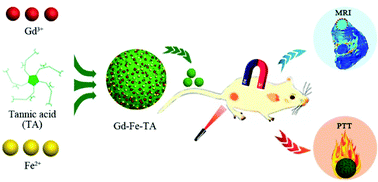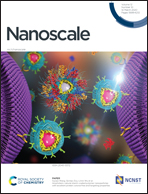Synthesis of gadolinium/iron–bimetal–phenolic coordination polymer nanoparticles for theranostic applications†
Abstract
Integration of diagnostic and therapeutic components into a single coordination polymer nanoparticle is desirable for theranostic applications, but still challenging. Herein, we report the synthesis of bimetal–phenolic coordination polymer nanoparticles using gadolinium nitrate and ferrous sulphate as a metal source, and plant polyphenols (i.e., tannic acid) as an organic ligand via a metal–catechol coordination assembly process. Such coordination polymers show a tunable molar ratio of Gd/Fe and high dispersibility and stability in aqueous solution. The coordination polymers reveal composition-dependent performance for longitudinal relaxivity and photothermal conversion. The longitudinal relaxivity is positively related to the molar ratio of Gd/Fe, while the photothermal performance is negatively related to the molar ratio of Gd/Fe in the coordination polymers. The coordination polymers with an optimized molar ratio of Gd/Fe exhibit an ultra-small hydrodynamic diameter (∼23 nm), a high r1 value (9.3 mM−1 s−1) with low r2/r1 (1.26) and high photothermal conversion efficiency (η = 37%). They can be used as a contrast agent for T1-weighted magnetic resonance imaging of EMT-6 tumor bearing mice, which can effectively enhance the signals of tumors. They can also effectively suppress tumor growth via photothermal therapy. This work brings new insights for the synthesis of multifunctional coordination polymer nanoparticles and extending their potential applications in theranostics.



 Please wait while we load your content...
Please wait while we load your content...